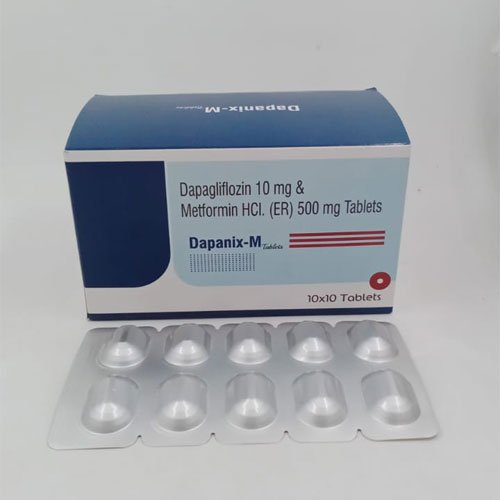- Home
- DIABETIC RANGE
- Glimepiride 3mg and Metformin Hydrochloride 1000mg Tablets

Telmisartan 40 Mg Tablets
October 8, 2020
Teneligliptin Tablets
October 8, 2020Glimepiride 3mg and Metformin Hydrochloride 1000mg Tablets
GLEMISAP®-M3 FORTE
Glimepiride and Metformin Hydrochloride are two medications used in combination to manage type 2 diabetes. This combination therapy helps to lower blood glucose levels in patients with type 2 diabetes who are not able to achieve adequate control with diet and exercise alone.
How the Combination Works Glimepiride:
Mechanism: Glimepiride stimulates the beta cells in the pancreas to release more insulin. This helps lower blood glucose levels by increasing the amount of insulin available to the cells.
Effect: By enhancing insulin secretion, Glimepiride helps control blood sugar levels after meals and throughout the day.
Metformin Hydrochloride:
Mechanism: Metformin works primarily by decreasing glucose production in the liver and improving insulin sensitivity in muscle cells. This helps the body use insulin more effectively and lowers blood glucose levels.
Effect: Metformin helps to lower fasting blood glucose levels and improve overall glucose control.
Benefits of the Combination Therapy
Effective Blood Sugar Control: The combination of Glimepiride and Metformin provides a dual approach to managing blood glucose levels. Glimepiride enhances insulin secretion, while Metformin improves insulin sensitivity and decreases liver glucose production, leading to better overall glycemic control.
Complementary Mechanisms: By targeting different mechanisms of glucose regulation, this combination therapy can provide more comprehensive blood sugar management compared to either medication alone.
Weight Management: Metformin is associated with minimal weight gain and may even help with weight loss. Glimepiride, while less likely to cause weight gain than other sulfonylureas, can contribute to weight management when used with Metformin.
Improved Glycemic Control: The combination of these two medications can effectively lower both fasting and postprandial (after meal) blood glucose levels, reducing the risk of diabetes-related complications such as cardiovascular disease, neuropathy, and nephropathy.
Reduced Risk of Hypoglycemia: When used appropriately, the combination of Glimepiride and Metformin may have a lower risk of causing hypoglycemia (low blood sugar) compared to higher doses of Glimepiride alone.
How to Use Glimepiride 1 mg and Metformin Hydrochloride 1000 mg Tablets IP
The combination tablet should be taken as prescribed by your healthcare provider. The typical starting dose is one tablet taken orally once or twice daily with meals to reduce gastrointestinal side effects.
Consistency: Take the medication at the same time each day to maintain consistent blood levels and achieve optimal effectiveness.
Diet and Exercise: Maintain a balanced diet and regular exercise regimen as advised by your healthcare provider to complement the effects of the medication.
Possible Side Effects
While this combination therapy is effective, it can cause side effects.
Common Side Effects:
Gastrointestinal Issues: Metformin can cause gastrointestinal side effects such as nausea, vomiting, diarrhea, and abdominal discomfort. These symptoms often improve with time or dosage adjustments.
Headache: Some patients may experience headaches as a common side effect.
Serious Side Effects:
Hypoglycemia: Glimepiride can cause low blood sugar, which may lead to symptoms such as sweating, shakiness, confusion, and dizziness.
Symptoms include muscle pain, difficulty breathing, abdominal pain, and feeling very weak or tired.
Allergic Reactions: Severe allergic reactions to either medication are rare but can happen.
Vitamin B12 Deficiency: Long-term use of Metformin can lead to a deficiency in vitamin B12, which may cause symptoms such as fatigue, weakness, and anemia.
Precautions and Warnings
Kidney Function: Both medications are excreted through the kidneys, so use with caution in patients with kidney impairment.
Liver Function: Metformin is processed by the liver, so it is important to use it with caution in patients with liver disease.
Pregnancy and Lactation: The safety of this combination during pregnancy and breastfeeding has not been fully established. Use only if needed and under the guidance of your healthcare provider.
Drug Interactions: Inform your healthcare provider of all medications, including over-the-counter drugs and supplements, as there may be interactions that affect blood glucose control or increase the risk of side effects.
Lifestyle and Dietary Considerations
In addition to medication, adopting a healthy lifestyle is crucial for effective diabetes management:
Balanced Diet: Follow a diet that is low in simple sugars and high in fiber.
Regular Exercise: Engage in regular physical activity, such as walking, swimming, or cycling, to help manage blood sugar levels and improve overall health.
Monitoring Blood Sugar: Regularly monitor blood glucose levels as advised by your healthcare provider to ensure the medication is effectively managing your condition.
Monitoring and Follow-Up
Regular follow-up appointments with your healthcare provider are essential for monitoring your condition and adjusting the treatment as needed. Your healthcare provider will assess your response to the medication, monitor for side effects, and make any necessary adjustments to your treatment plan.
Conclusion
Glimepiride 1 mg and Metformin Hydrochloride 1000 mg Tablets IP offer a powerful combination for managing type 2 diabetes. By combining sulfonylurea and biguanide, this therapy provides a dual approach to controlling blood glucose levels, improving overall glycemic control, and reducing the risk of diabetes-related complications.
| Packing | 10×15 Blister |
|---|






